a. Verständnis der digitalen Gesichtsersatztechnologie
Die digitale Gesichtserkennung stellt einen bahnbrechenden Fortschritt in der Datenschutztechnologie dar und ermöglicht es Forschungseinrichtungen, sensible Informationen zu schützen und gleichzeitig die Datenintegrität zu wahren. Diese KI-gestützte Lösung erkennt und ersetzt automatisch Gesichtsmerkmale in Bildern und Videos und gewährleistet so die Anonymität der Probanden, ohne den für Forschungszwecke benötigten wertvollen Kontext zu beeinträchtigen.
Die Entwicklung des digitalen Gesichtsersatzes ist bemerkenswert und hat sich von der einfachen Pixelmaskierung zu hochentwickelten KI-gesteuerten Lösungen entwickelt. Ursprünglich für die Unterhaltungs- und Medienindustrie entwickelt, hat diese Technologie entscheidende Anwendungen in Forschungsumgebungen gefunden, in denen der Schutz der Privatsphäre der Teilnehmer von größter Bedeutung ist. Moderne Systeme können Tausende von Bildern gleichzeitig verarbeiten und dabei eine gleichbleibende Qualität beibehalten, während wichtige Gesichtsausdrücke und emotionale Hinweise, die für Forschungsergebnisse relevant sein könnten, erhalten bleiben.
Forschungseinrichtungen stehen heute vor großen Herausforderungen bei der Verwaltung großer Mengen visueller Daten und der Einhaltung immer strengerer Datenschutzbestimmungen. Herkömmliche Anonymisierungsmethoden erweisen sich oft als zeitaufwändig und können unbeabsichtigt wertvolle Forschungsdaten zerstören.
b. Der wachsende Bedarf an digitalem Gesichtsersatz
Mit der Verbreitung von hochauflösenden Kameras und dem weit verbreiteten Datenaustausch ist der Schutz der persönlichen Identität in Forschungsdaten so wichtig wie nie zuvor. Das Risiko der Re-Identifizierung durch fortschrittliche Gesichtserkennungstechnologien hat einen dringenden Bedarf an ausgefeilteren Methoden zum Schutz der Privatsphäre geschaffen.
Gesetzliche Rahmenbedingungen wie GDPR, HIPAA und verschiedene Ethikrichtlinien für die Forschung schreiben robuste Datenschutzmaßnahmen vor. Forschungseinrichtungen müssen nun umfassende Strategien zum Schutz der Privatsphäre nachweisen, insbesondere wenn sie mit sensiblen Daten von gefährdeten Bevölkerungsgruppen umgehen oder grenzüberschreitende Forschungskooperationen durchführen.
Die Auswirkungen auf Forschungseinrichtungen sind erheblich. Ohne wirksame Lösungen für den Ersatz digitaler Gesichter sehen sich die Einrichtungen mit Einschränkungen beim Datenaustausch, bei den Möglichkeiten der Zusammenarbeit und beim Umfang der Forschung konfrontiert. Darüber hinaus kann das Risiko von Datenschutzverletzungen zu schwerwiegenden Konsequenzen führen, einschließlich rechtlicher Strafen, Verlust von Fördermitteln und Schädigung des Rufs der Einrichtung. Diese Technologie ist für die Wahrung der Integrität der Forschung bei gleichzeitiger Einhaltung von Vorschriften und dem Schutz der Privatsphäre der Probanden unerlässlich geworden.
Erfahren Sie mehr in unserem Leitfaden auf : bild anonymisieren
1. Grundlagen der digitalen Gesichtsersatztechnologie

a. Funktionsweise des digitalen Gesichtsersatzes
Die digitale Gesichtsersatztechnologie stellt einen bahnbrechenden Fortschritt in der Bildverarbeitung dar, der durch hochentwickelte KI-Algorithmen unterstützt wird. Im Kern nutzt das System Deep-Learning-Modelle, die Gesichtsmerkmale in Bildern präzise erkennen und zuordnen. Diese KI-gestützten Mechanismen analysieren die wichtigsten Gesichtsmerkmale und gewährleisten eine genaue Identifizierung unabhängig von Blickwinkeln und Lichtverhältnissen.
Die Technologie nutzt fortschrittliche Algorithmen, die identifizierte Gesichter nahtlos ersetzen und dabei die Authentizität des Bildes erhalten. Durch neuronale Netzwerke, die auf umfangreichen Datensätzen trainiert wurden, bewahrt das System wichtige Details wie Hautbeschaffenheit, Lichtverhältnisse und Gesichtsausdrücke und sorgt so für natürlich wirkende Ergebnisse.
b. Wesentliche Merkmale des modernen digitalen Gesichtsersatzes
Moderne Lösungen für die Ersetzung von Gesichtern bieten leistungsstarke Stapelverarbeitungsfunktionen, mit denen Forscher große Datensätze effizient verarbeiten können. Die Technologie verarbeitet Tausende von Bildern gleichzeitig, was die manuelle Verarbeitungszeit drastisch reduziert. Funktionen für die Ersetzung in Echtzeit ermöglichen eine sofortige Visualisierung der Ergebnisse und erleichtern die Qualitätskontrolle und Anpassungen.
Ein weiterer Eckpfeiler sind die Integrationsmöglichkeiten mit flexiblen APIs und Plugins, die sich nahtlos in bestehende Forschungsabläufe und Datenverwaltungssysteme einfügen. Diese Interoperabilität gewährleistet eine reibungslose Implementierung bei gleichzeitiger Wahrung von Datensicherheitsprotokollen und Forschungsintegrität.
Diese Funktionen ergeben zusammen eine robuste Lösung, die Effizienz und Genauigkeit in Einklang bringt und damit für Forschungseinrichtungen, die mit sensiblen visuellen Daten arbeiten, von unschätzbarem Wert ist.
2. Vorteile des digitalen Gesichtsersatzes für die Forschung
a. Vorteile des Schutzes der Privatsphäre
Die digitale Gesichtsersatztechnologie bietet einen robusten Datenschutz, der die strengen GDPR- und HIPAA-Anforderungen erfüllt. Durch die automatische Erkennung und Ersetzung von identifizierbaren Gesichtsmerkmalen können Forschungseinrichtungen die Anonymität der Teilnehmer sicherstellen und gleichzeitig die Datenintegrität wahren. Diese Technologie ist besonders wichtig für den Schutz gefährdeter Bevölkerungsgruppen, darunter Minderjährige, Patienten und Risikogruppen, und ermöglicht es Forschern, sensible Studien durchzuführen, ohne die Privatsphäre zu gefährden.
Die Standards der Forschungsethik werden durch konsistente und zuverlässige De-Identifizierungsprozesse aufrechterhalten, die die Einhaltung der Anforderungen des institutionellen Prüfungsausschusses (IRB) und internationaler Forschungsprotokolle gewährleisten.
b. Operative Vorteile
Die Implementierung der digitalen Gesichtsersetzung rationalisiert die Arbeitsabläufe in der Forschung erheblich. Was früher stundenlanges manuelles Verpixeln oder Unschärfen erforderte, kann jetzt durch automatisierte Stapelverarbeitung in wenigen Minuten erledigt werden. Diese Effizienz führt zu erheblichen Kosteneinsparungen - im Vergleich zu herkömmlichen manuellen Methoden können die Arbeitskosten um bis zu 80% gesenkt werden.
Darüber hinaus erleichtern sichere de-identifizierte Daten die Zusammenarbeit in der Forschung. Einrichtungen können Datensätze ohne Bedenken hinsichtlich des Datenschutzes über Grenzen und Organisationen hinweg austauschen, was den Forschungsfortschritt beschleunigt und Studien größeren Umfangs ermöglicht. Dieses kollaborative Potenzial eröffnet neue Möglichkeiten für institutionsübergreifende Forschungsprojekte und Meta-Analysen, die letztlich die wissenschaftliche Entdeckung vorantreiben und gleichzeitig die höchsten Standards für den Schutz der Privatsphäre einhalten.
3. Bewährte Verfahren für die digitale Gesichtsersetzung
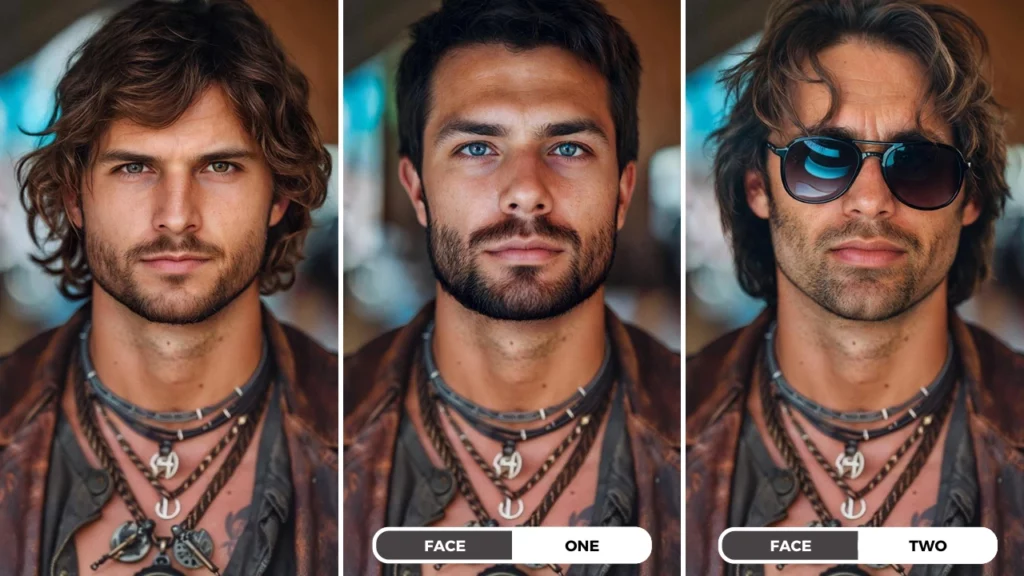
a. Qualitätsstandards
- Bildauflösung: Achten Sie auf hochauflösende Bilder, um optimale Ergebnisse zu erzielen. Bilder mit niedriger Auflösung können zu Artefakten oder Verzerrungen in den ersetzten Flächen führen.
- Beleuchtungsbedingungen: Eine einheitliche Beleuchtung über alle Bilder hinweg ist für eine nahtlose Integration entscheidend.
- Gesichtszüge: Klare und gut definierte Gesichtszüge sind für eine exakte Gesichtserkennung unerlässlich.
b. Verarbeitungsrichtlinien
- Stapelverarbeitung: Nutzen Sie Tools, die die Stapelverarbeitung unterstützen, um den De-Identifizierungsprozess für große Datensätze zu rationalisieren.
- Qualitätskontrolle: Einführung eines strengen Qualitätskontrollverfahrens zur Überprüfung de-identifizierter Bilder und zur Gewährleistung der Genauigkeit.
- Versionskontrolle: Pflege der Versionskontrolle von Original- und anonymisierten Bildern, um Änderungen zu verfolgen und Prüfungen zu erleichtern.
c. Sicherheitsmaßnahmen
- Datenschutz: Umsetzung solider Sicherheitsmaßnahmen zum Schutz sensibler Daten, einschließlich Verschlüsselung und Zugangskontrolle.
- Zugangskontrolle: Beschränken Sie den Zugang zu De-Identifizierungs-Tools und Daten auf autorisiertes Personal.
- Audit Trail: Führen Sie detaillierte Prüfpfade, um alle Aktivitäten im Zusammenhang mit der Datenverarbeitung und der De-Identifizierung zu verfolgen.
- Regelmäßige Sicherheitsaudits: Durchführung regelmäßiger Sicherheitsprüfungen zur Ermittlung und Behebung potenzieller Schwachstellen.
Durch die Befolgung dieser bewährten Verfahren können Forschungseinrichtungen die ethische und sichere Implementierung des digitalen Gesichtsersatzes gewährleisten, die Privatsphäre des Einzelnen schützen und die Datenschutzbestimmungen einhalten.
4. Digitale Gesichtsersatzanwendungen
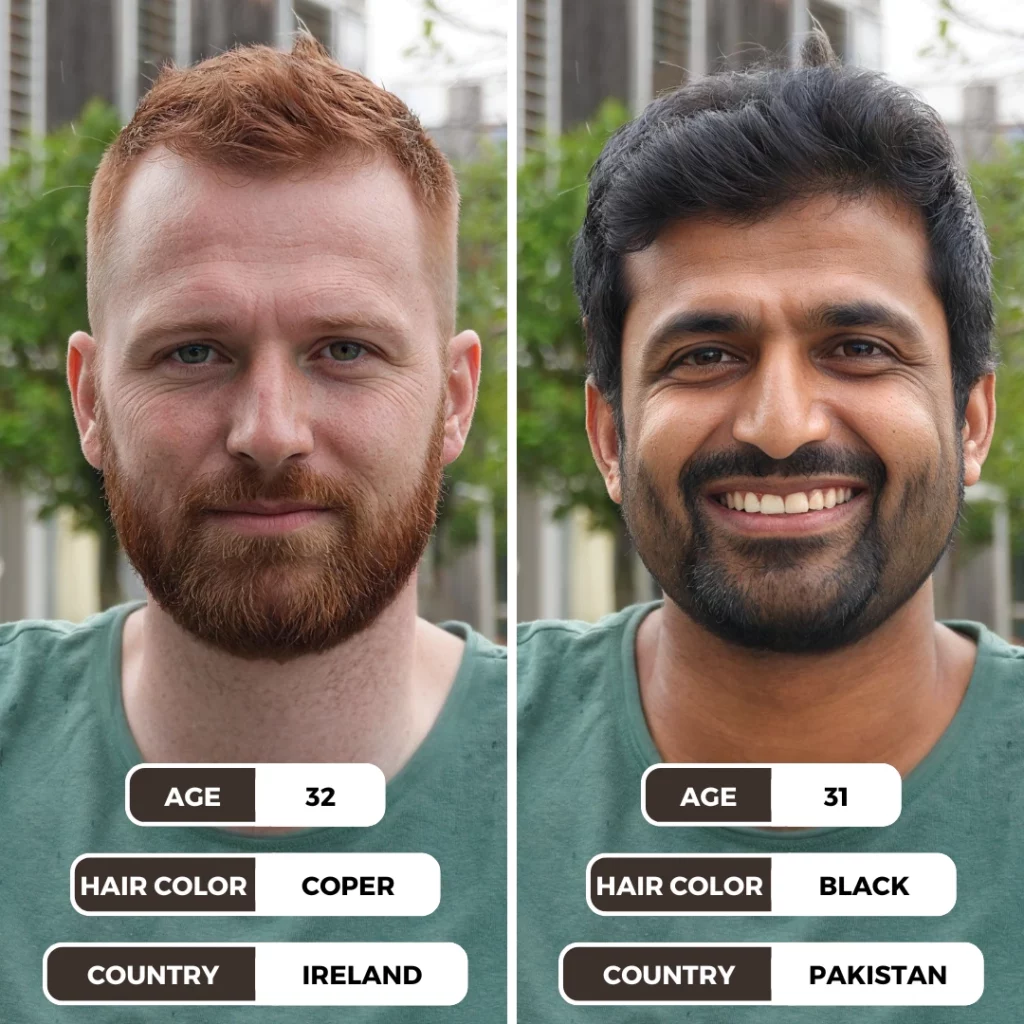
a. Anwendungsfälle in der Forschung
i. Anwendungen in der medizinischen Forschung:
- Datenschutz für Patienten: Schutz der Privatsphäre von Patienten durch Anonymisierung medizinischer Bilder.
- Fernzusammenarbeit: Erleichterung des sicheren Austauschs sensibler medizinischer Daten zwischen Einrichtungen.
- KI und maschinelles Lernen: Trainieren Sie KI-Modelle auf de-identifizierten medizinischen Bildern, um die Diagnosegenauigkeit zu verbessern.
ii. Sozialwissenschaftliche Studien:
- Datenschutz für Teilnehmer: Schutz der Privatsphäre der Studienteilnehmer, insbesondere in sensiblen Forschungsbereichen.
- Interkulturelle Studien: Ermöglicht kulturübergreifende Forschung durch Anonymisierung von Bildern aus verschiedenen Bevölkerungsgruppen.
- Längsschnittstudien: Verfolgen Sie Personen über einen längeren Zeitraum, ohne ihre Privatsphäre zu gefährden.
iii. Forschung im Bereich der öffentlichen Gesundheit:
- Epidemiologische Studien: Analysieren Sie große Datensätze medizinischer Bilder unter Wahrung der Anonymität der Patienten.
- Überwachung der öffentlichen Gesundheit: Überwachung von Krankheitstrends und Erkennung von Krankheitsausbrüchen ohne Beeinträchtigung der Privatsphäre des Einzelnen.
- Klinische Studien: Bewertung der Wirksamkeit von Behandlungen und Eingriffen, ohne die Identität der Patienten preiszugeben.
b. Institutionsübergreifende Zusammenarbeit
i. Sicherer Datenaustausch mit digitalem Gesichtsersatz:
- Erleichterung der gemeinsamen Nutzung von Daten: Ermöglichung des sicheren Austauschs nicht identifizierter Daten zwischen Einrichtungen.
- Standardisierung von Datenformaten: Entwicklung gemeinsamer Standards für anonymisierte Daten, um Kompatibilität und Interoperabilität zu gewährleisten.
- Vertrauen aufbauen: Förderung des Vertrauens und der Zusammenarbeit zwischen Forschern durch den Schutz sensibler Informationen.
ii. Multizentrische Forschungsprojekte:
- Daten zusammenführen: Kombinieren Sie Daten aus mehreren Einrichtungen, um den Stichprobenumfang und die statistische Aussagekraft zu erhöhen.
- Daten harmonisieren: Standardisierung der Methoden zur Datenerfassung und -verarbeitung, um die Konsistenz zwischen den verschiedenen Standorten zu gewährleisten.
- Beschleunigung der Forschung: Erleichterung der gemeinschaftlichen Forschung und Beschleunigung wissenschaftlicher Entdeckungen.
iii. Möglichkeiten der internationalen Zusammenarbeit:
- Globaler Datenaustausch: Ermöglichen Sie die internationale Zusammenarbeit, indem Sie Daten de-identifizieren und grenzüberschreitend austauschen.
- Interkulturelle Forschung: Untersuchung verschiedener Bevölkerungsgruppen und Ermittlung globaler Trends.
- Globale Gesundheit vorantreiben: Tragen Sie zu globalen Gesundheitsinitiativen bei, indem Sie de-identifizierte Daten für Analysen und Forschungszwecke zur Verfügung stellen.
5. Messung des Erfolgs des digitalen Gesichtsersatzes
a. Leistungsmetriken
Um die Effektivität eines digitalen Gesichtsersatztools zu bewerten, sollten Sie die folgenden Leistungskennzahlen berücksichtigen:
- Verarbeitungsgeschwindigkeit: Beurteilen Sie, wie schnell das Tool große Bilddatensätze verarbeiten kann.
- Genauigkeit: Bewerten Sie die Genauigkeit der Gesichtserkennung und -ersetzung unter Berücksichtigung von Faktoren wie Gesichtsausrichtung und Ausdruckserhaltung.
- Bildqualität: Beurteilen Sie die Qualität der ausgegebenen Bilder, einschließlich der Auflösung, der Farbgenauigkeit und der allgemeinen visuellen Attraktivität.
b. Kosten-Nutzen-Analyse
- Geringere Arbeitskosten: Berechnen Sie die Einsparungen durch die Automatisierung des De-Identifizierungsprozesses.
- Gesteigerte Effizienz: Messen Sie die Zeitersparnis durch die Verwendung des Tools im Vergleich zu manuellen Methoden.
- Verbesserte Datenqualität: Bewertung der Auswirkungen einer genauen und konsequenten De-Identifizierung auf die Forschungsergebnisse.
c. ROI-Bewertung
- Langfristige Vorteile: Bedenken Sie die potenziellen langfristigen Vorteile, wie z. B. eine bessere Einhaltung des Datenschutzes und bessere Möglichkeiten des Datenaustauschs.
- Risikominderung: Bewertung des geringeren Risikos von Datenschutzverletzungen und rechtlichen Verpflichtungen.
- Verbesserte Forschungszusammenarbeit: Untersuchen Sie, wie der digitale Gesichtsersatz die Zusammenarbeit mit anderen Institutionen erleichtern kann.
Durch die sorgfältige Berücksichtigung dieser Faktoren können Forschungseinrichtungen fundierte Entscheidungen über die Einführung und Nutzung digitaler Gesichtsersatzwerkzeuge treffen.
6. Leitfaden zur Implementierung: Erste Schritte mit dem digitalen Gesichtsersatz
a. Schritt-für-Schritt-Setup-Prozess:
i. Erstellen Sie ein EraseID-Konto:
- Besuchen Sie die EraseID Website und melden Sie sich für ein kostenloses Konto an.
- Geben Sie die erforderlichen Informationen an, um ein Konto zu erstellen.
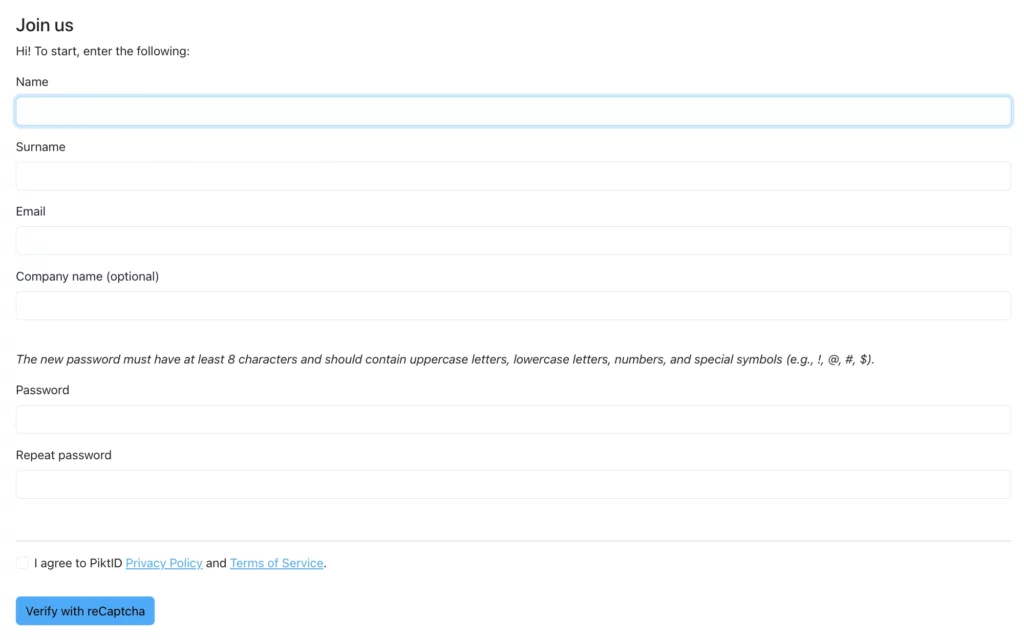
ii. Bilder hochladen:
- Einloggen zu Ihrem EraseID-Konto.
- Verwenden Sie die intuitive Schnittstelle, um die Bilder hochzuladen, die Sie de-identifizieren möchten.

iii. Wählen Sie die De-Identifizierungsmethode:
- Wählen Sie den "Identität löschenFunktion".
- Dadurch wird das KI-gesteuerte Gesichtsersatz-Tool aktiviert.

iv. Einstellungen anpassen:
- Passen Sie Einstellungen wie ethnische Zugehörigkeit und Alter Ihres Motivs an, und wählen Sie aus einer Reihe von gewünschten Stilen der Ersatzgesichter und anderen Parametern.
- Diese Optionen ermöglichen eine Feinabstimmung des De-Identifizierungsprozesses auf spezifische Anforderungen.

v. Bilder verarbeiten:
- Initiieren Sie den De-Identifizierungsprozess.
- Die KI von EraseID analysiert und verarbeitet automatisch jedes Bild und ersetzt Gesichter durch realistische und vielfältige Alternativen.
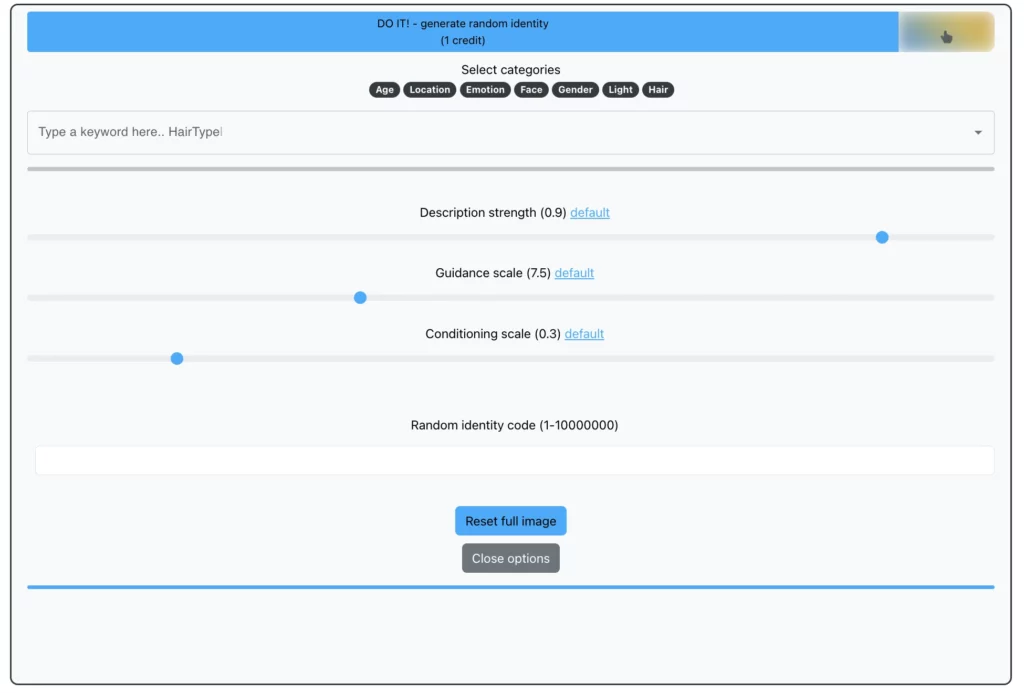
vi. Überprüfung und Download:
- Sobald der Prozess abgeschlossen ist, überprüfen Sie die de-identifizierten Bilder, um Qualität und Genauigkeit zu gewährleisten.
- Laden Sie die de-identifizierten Bilder zur weiteren Verwendung oder Analyse herunter.
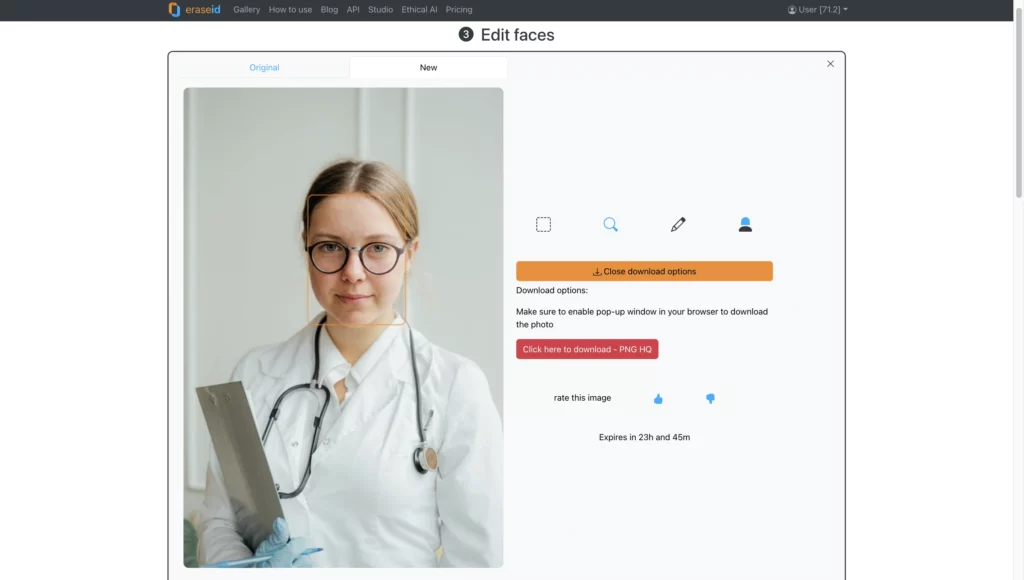
b. Leitfaden für den Grundbetrieb:
- Unterstützung von Bildformaten: EraseID unterstützt verschiedene Bildformate, darunter JPEG, PNG und BMP.
- Anpassbare Einstellungen: Feinabstimmung des De-Identifizierungsprozesses, um die gewünschten Ergebnisse zu erzielen.
- Sicherheit und Datenschutz: EraseID legt großen Wert auf Datenschutz und Sicherheit und stellt sicher, dass Ihre Bilder mit Sorgfalt behandelt werden.
Wenn Sie diese Schritte befolgen und die benutzerfreundliche Oberfläche von EraseID nutzen, können Forscher ihre Bilder einfach und effektiv de-identifizieren und die Einhaltung von Datenschutzbestimmungen und ethischen Standards sicherstellen.

7. Stärkung der Forschung durch ethische und wirksame digitale Gesichtsersetzung
Die Technologie zur Ersetzung digitaler Gesichter durch EraseID stellt eine transformative Lösung für Forschungseinrichtungen dar, die ein Gleichgewicht zwischen dem Datenschutz und dem Potenzial der Zusammenarbeit herstellen wollen. Diese Technologie gewährleistet nicht nur die Einhaltung gesetzlicher Vorschriften, sondern verbessert auch die betriebliche Effizienz im Umgang mit sensiblen visuellen Daten erheblich.
a. Wichtigste Erkenntnisse
Die Implementierung von EraseID bietet drei entscheidende Vorteile:
- Automatisierter Schutz der Privatsphäre, der eine Genauigkeit von 99,9% bei der Erkennung und Ersetzung von Gesichtern erreicht
- Bis zu 80% Zeitersparnis bei der Datenverarbeitung im Vergleich zu manuellen Methoden
- Nahtlose Einhaltung von GDPR, HIPAA und anderen Datenschutzbestimmungen unter Wahrung der Datenintegrität
Der Erfolg bei der Umsetzung hängt ab von:
- Umfassende Schulung des Personals
- Klare Datenschutzprotokolle
- Regelmäßige Systemaudits und Aktualisierungen
- Starke Rahmenwerke für die Datenverwaltung
b. Zusätzliche Ressourcen
- Bester AI Headshot Generator: Die beste Wahl für professionelle Fotos
- AI Face Fixer, den Sie für starke Kreativität kennen sollten
- Wie man mit Smiling Face AI fröhliche Vorschaubilder erstellt
- Wie der Charakter-KI-Generator neue Ideen hervorbringt
- Der beste Weg, um einem Foto ein Lächeln hinzuzufügen
Sind Sie bereit, Ihre Forschung zu unterstützen?
Melden Sie sich noch heute für EraseID an und erleben Sie die Leistungsfähigkeit der KI-gestützten De-Identifizierung. Schützen Sie Ihre Forschung, wahren Sie die Privatsphäre und beschleunigen Sie Ihre Entdeckungen.
Besuchen Sie EraseID, um mehr zu erfahren und Ihre Reise zu einer datenschutzorientierten Forschung zu beginnen.

